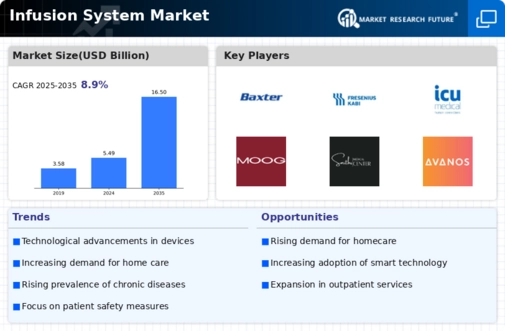Market Trends
Key Emerging Trends in the Infusion Systems Market
Trends are changing quickly in the IV systems market. This is because healthcare technology is getting better and patient-centered care is becoming more important. This field is very important for making sure that fluids, medicines, and nutrients are given precisely and safely, which has an impact on the whole field of healthcare. One big trend is that more and more modern technologies are being added to infusion devices. For example, smart infusion pumps are becoming more popular because they have features like reducing dose errors, being able to join wirelessly, and tracking in real time. These new ideas not only make patients safer, but they also help make healthcare more efficient. There is a clear trend toward healthcare at home, which has caused a huge demand for infusion devices that can be used outside of standard healthcare spaces. Home infusion therapy lets patients choose when and where to get treatments, so they can be more comfortable. This can help patients get better care and keep costs down. As more outpatient infusion treatments become available, ambulatory infusion sites are becoming more popular. These kinds of centers are popping up more and more in the market because people need affordable medical care and more and more people have chronic diseases that need long-term infusion treatments. As medical treatments get more complicated, there is a greater need for specialized infusion systems that are made to work in certain healing areas. These systems are made to meet the specific needs of different medical fields, such as cancer, pain management, and immunity. They give medical workers the tools they need to give accurate and effective treatments. More and more healthcare systems are using data to make decisions, and infusion systems are no different. Trends in the market include combining internet and data analytics features, which help healthcare workers learn more, keep an eye on how patients are responding, and make treatment plans more effective. This strategy that is focused on data helps make medicine more specific and improves the general quality of healthcare. The market for infusion devices is growing quickly around the world, with major players carefully expanding their reach into new areas. There is also a trend for markets to get smaller, with mergers and deals changing the way competition works. This merging is happening because businesses need to offer more products and get a bigger part of the market. The market for infusion devices is being affected more and more by uniformity and following the rules. Tough rules are meant to make sure that these systems are safe and work well, which forces companies that make them to spend money on research and development to meet and beat those rules. This focus on compliance helps healthcare workers and end users trust each other. Even though there are some good signs, problems like high start-up costs and worries about security in smart infusion systems still exist. But the market for infusion systems is expected to keep growing because of new technologies, a focus on patient-centered care, and more people getting chronic diseases that need advanced infusion treatments. People who have a stake in the industry can look forward to a future with more sustainable and patient-friendly healthcare options, better patient results, and more efficient operations.












Leave a Comment